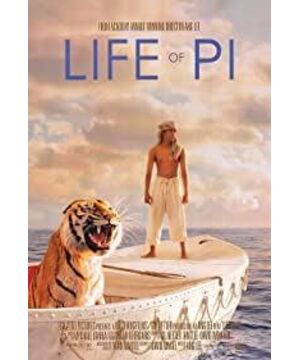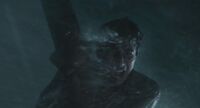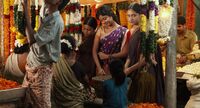In an interview with mainland media, Ang Lee said that as a photographer, he has a clear answer to everything in his heart, but he will never say it. This may be his invitation letter, writing: Please explore with me.
■Over-interpretation related to the background
■Hometown: The truth
of Pondicherry The faction in the movie grew up in Pondicherry, and the current translation is: Pondicherry-Pondicherry. It used to be the capital of French India, with a deep French brand. After joining India from French jurisdiction in 1954, it enjoyed full autonomy in the early days. French, like the native Tamil, is still the prevailing language here. Sri Aurobindo, one of the three holy saints of India, "enlightened" here - yes, he studied philosophy, mysticism and yoga. Various religions, mainly Hinduism and Christianity, coexist wonderfully in Pondicherry.
The political background in the film that forced the family to make a decision to cross the ocean refers to the mid-1970s, when the ruling Indira Gandhi (Daughter of Nehru) declared the country to enter a "state of emergency" in order to crack down on the opposition party: the arrest of the opposition party leaders, stop enforcing a series of constitutional rights for citizens, and implement strict censorship of the press. It was later considered to be the "darkest period" in the history of contemporary Indian democracy.
There is no zoo in the real Pondicherry. There is a botanical garden not far from the beach. Ang Lee used this botanical garden as a prototype to "build" the zoo in the movie with later technology.
■Hinduism: Three Lotuses and three Vishnus
The earliest sect to convert is the local Hinduism, and the teacher is his mother (the Indian teacher in the original novel is one of his aunts, in the movie: although his mother is highly educated , ideas are new, but faith is her only connection to the past). In Hinduism, Brahma (Brahma, creator), Vishnu (Vishnu, defender) and Shiva (Mahesh, destroyer) are trinity.
According to legend, Vishnu was sleeping on the body of the serpent Ananta coiled like a bed, floating on the sea of the universe. In the eyes of many, this is one of the metaphorical possibilities of "Cannibal Island"; there are also two places where Vishnu appears in the film: Pi thanks Vishnu for guiding him to Christ; Pi sheds tears after killing the fish Pray to him, the source may be - in mythology, Vishnu once incarnated as a fish to save the ancestor of mankind, Manu.
Lotus also appears three times in the film. Once it was a pattern drawn by the mother on the ground, once Ananti made a lotus gesture in a dance, and once it was the shape of a flower encasing human teeth on a man-eating island.
Hinduism: Three-time lotus, three-time Vishnu sect girlfriend said that the lotus (life) is hidden in the forest, which may be the reason why pie tied the bracelet given by his girlfriend to the root of the tree. In addition, in Indian mythology, when Vishnu woke up, a lotus flower grew from his navel, and Brahma, born in the lotus, began to create the world, and at the end of the catastrophe Shiva destroyed the world—creation and destruction , to match Cannibal Island's setting that creates both happiness and pain.
Dancing Ananti: Ang Lee's first love?
Pai's first love girlfriend, Ananti who dances, is a character inserted by Li An. Although there is no serious mention of Pi's first love in the novel, it is described at the end of the first part: Pi meets a little brown-skinned girl, healthy, beautiful, and unrestrained. She secretly looks at Pi from behind her father's legs, but this girl only has 4 years.
Song and dance have a special status in India, which is established from the four Vedas, the oldest classics in Indian history. One of them is called "Sama Veda", which believes that the witchcraft and magic that entertains the gods with singing and dancing or channeling in human civilization and culture all inherit the name of "Sama". The movie also emphasizes in the dance class that the "Anantis" should contact and communicate with their own energy and gods through dance.
By the way, let's speculate on the name of "Ananti", but it is only speculation, not exact: "Nandi" is the mount and pet of Shiva, the god of Indian dance, the partner of the gods, and the representative of India's "holy cow". According to legend, there is an incarnation of Lord Shiva on the back of each sacred cow watching the world.
■Two details: Pie's book, and the priest's question
—of course, these two may be interesting coincidences.
Name: Pi and Richard Parker, the young Pi sat on a bridge pier and read a book before leaving India. The cover of the book was a boy and a tiger; Pi went to church to steal holy water after a bet with his brother, the first after the priest appeared. A line is: "are you thirsty?" - we all know that if this tiger hadn't been mistaken by yin and yang, its original name should have been "Thirsty". What is even more interesting is that the animals appear one after another on the title, and only the tiger appears in the form of a reflection, and the name of the director Ang Lee appears simultaneously at this time.
■Name: Pie and Richard Parker
The origin of Pie is clearly explained in the movie. π, an endlessly irrational recurring number, is a meaningful symbol for the fate of pie. Pi's stubbornness and tenacity in reciting the value of π (this is indeed not in the original work, a detail added by Ang Lee himself), paved the way for his final survival.
Richard Parker may be more interesting: In 1884, the yacht "Mignonette" sank, and four survivors boarded a lifeboat and were stranded in the Atlantic Ocean, except for captain Thomas Dudley, first mate Edwin Stephens, crew Edmund Brooks , and a 17-year-old valet named Richard Parker, who is also an orphan. Richard Parker was weakened by drinking seawater because he did not listen to the dissuasion, and the other three chose to kill him who was so weak that he was dying and eat it to survive. This is the famous "Queen v Dudley and Stephens case" (R v Dudley and Stephens) later in ethics and law. - On the facts found by the jury, the judge convicted the trio of manslaughter and sentenced them to hang, but on the advice of Sir Harcourt, who supported the prosecution, Queen Victoria pardoned the trio.
In addition, in Edgar Allan Poe's novel "The Story of Arthur Gordon Pym", there is also the story of a shipwreck named Richard Parker. In the Western context, this name is often associated with metaphors such as drifting, cannibalism, and cannibalism.
■Overinterpretation of animals and plants
Why hyenas, zebras, orangutans and tigers?
The dictionary's explanation is - hyenas, eating the carrion of animal carcasses, are fierce and unusual; zebras are most likely to be hunted by hyenas and lions on the African grasslands; orangutans will wander independently in adulthood, while females still play the role of image of mother.
If the second story is true, the film has actually done enough foreshadowing: the rejoicing Buddhist sailor, when the zebra jumped into the lifeboat, kept shouting "Zebra! Zebra!" in Chinese; when Pi asked the orangutan your child When the orangutan was full of sadness. Pi's father tells Pi that all you see in the tiger's eyes is your own reflection. This also seems to explain why the tiger jumped out of the canvas to kill the hyena after the hyena killed the orangutan. Many people believed that the pie at the moment was stimulated to release the evil in their hearts.
It is worth mentioning that the cook\hyena, who plays less than 1 minute, is played by Gerard Depardieu, a French national treasure actor who is world-renowned for his role in "Love with a Big Nose". In the setting of the original book, this is a sea-going ship that mainly transports cargo. The crew consists of three parts, the highest class is French, the middle class is Japanese, and the lowest class is Taiwanese, which may explain The reason for looking for Taiwanese actor Wang Bojie to play Suixi Buddhist Crew.
Tiger, what is it?
■Three mainstream views:
One is the animal nature and evil of the sect. After his mother was killed by the cook, Pai released the tiger in his heart; because of his religious beliefs since childhood, he was afraid of this animal nature and evil, but this animal nature and evil allowed him to continue his life. There is a story in the original book that was not shown in the movie - when Pi was on the verge of death, he lost his sight in both eyes, when his lifeboat met another lifeboat, and the people on the other lifeboat were also blind in both eyes. In order to survive, he tried to kill Pi and take the biscuits, but he did not expect that there was a tiger on Pi's boat, and it was Richard Parker who killed the person who came. A few days later, Pi regained his sight and found that only the skull was left.
The second is Pai's other self-incarnation, the terrifying close friend he imagined, who accompanies him through loneliness and despair in his heart. There is this confession in the original book: "Let me tell you a secret: Sometimes I am happy because Richard Parker exists, and a part of me doesn't want Richard Parker to die, because if he dies, then I Will survive alone in despair. And despair is a more formidable enemy than tigers. If I have any desire to survive, then I would like to thank Richard Parker, who gave me no time to think about my family and my misery I hate him because he forced me to live. But at the same time, I thank him for it. I am still grateful to him to this day. The truth is simple: if it weren't for Richard Parker, I wouldn't be today. I will live to tell you my story." The
third is fear and despair itself. The drifting process of pie is the process of adulthood and self-discovery, and the process of taming the tiger is the process of overcoming fear and despair.
The truth about Cannibal Island and Meerkat?
As mentioned above, the Cannibal Island is a metaphor for the teachings of Hinduism, the incarnation of Vishnu, and everything is but his dream. According to this, many people believe that the island is just a dream of the young Pi, after fainting. Dreams are the satisfaction of desires and the disorderly reconstruction of memories. Besides it doesn't make any sense. And the "evil" argument holds that the man-eating island is in the shape of a lying woman, or "mother", from which Pai gets his life supply-he happily ate the flesh of the people he was on board with, enjoying the physical After the basic needs, the teeth remind him that he can't stay in this desire for long to move on.
Interesting is the meerkat. These animals don't live on water, they live in the real world in deserts, in crypts. When Richard Parker chased after them, the other meerkats looked onlookers and indifferent, which some netizens thought meant human beings. Some people think that Zhang Huang's demeanor is the negative emotions and unease in the hearts of the metaphorists. The "evil" statement that corresponds to the above thought of getting supplies from "mother" is that meerkats are maggots that breed on carrion.
■Fluorescent whales: time and force majeure?
Pi tied food and water to a small raft outside the lifeboat, but was knocked over into the sea by a sudden wave of fluorescent whales. This is an extremely beautiful scene in the film. Many people think that luminous sea water is a fictional part of fantasy, but there are indeed microorganisms in the sea that fluoresce at night. A large number of jellyfish also glow because they devour these microorganisms. When the movement of the water intensifies, the microorganisms will quickly gather, which is why The part where the pie is hand-stirred with sea water will be brighter. In Hindu mythology, Vishnu often incarnates in various images to save mankind, the first image being a fish. In addition, Vishnu has a famous saying: I am time, the destroyer of all things. In the hearts of some viewers, this humpback whale, with its big mouth and huge wings, appeared suddenly, and its huge body represented force majeure. The curves drawn on the sea surface and the rotation of the body when leaving are in line with the simulacrum of time. These two "appearances" of Vishnu, one is to use fish for food to save Pi's life, and the other is a long sea drift, the passage of time and accidents at sea to kill Pi's food and sharpen Pi's will, spiritual growth.
■Science-related overinterpretation
Question: Can bananas really float?
The majority of netizens have done a quick experiment, showing that a banana thrown at random can float without pressure in tap water and brackish water. Nutshell's experiments showed that if the peel was peeled from the flesh, the peel would float faster, while the flesh would sink to the bottom quickly. But whether a bunch of bananas can carry the weight of an adult or an orangutan, there is no more scientific conclusion. [The following is a screenshot of the experiment of Uncle Bantian Umi]
Question: How did the tiger put the sheep into the fence?
Netizen A: The tiger is so powerful, it smashed the bones of the sheep by pulling hard!
Netizen B: The camera swept to the bottom of the fence and there was a big gap, and the sheep were dragged in there.
Netizen C: Doesn't it mean that where the head can pass through, the body can also pass through?
Netizen D: Why are there so many watching movies?
Question: Why are there flies and mice in the sea?
After drifting for a period of time in the sea where you can't see the edge, it is really hard to imagine that there will be flies gathering and mice appearing. However, these "two evils" are known to be extremely powerful, and they are likely to exist on the lifeboats, and only appear at the right time.
Question: Do tigers really eat fish, eat mice, and can swim?
Various search pages and Wikipedia pages show that tigers do not normally eat mice and fish. Apart from the fact that both are too small, the mice live in the holes and the fish live in the water, which are not in line with the hunting range of tigers. Tigers are indeed natural swimmers, however, with an innate ability and desire to swim.
■ "Over-interpretation" in relation to the subject
■ Inevitable question: What does Ang Lee want to convey?
Mainstream Myth 1: What you choose to believe is what You choose to believe
■ The first story is an oriental system of mystical inspiration, inconceivable events and/or symbolic (allegorical) expressions. The second story is the rationalism of the Western system, which can stand the verification of logic and experience. In the film, the storytellers do not ask the author which story do you think is true, but ask, which one do you prefer? Should we also pay attention to this detail: instead of asking which story is true, ask ourselves, which one do you prefer? This is why when the writer chooses to believe the first one, Pi said, "You choose to stand with God," and why the writer sees that Pi has a wife, daughter and son, and thinks it's a "happy ending."
■Mainstream theory 2: Do see the power of faith
This kind of view holds that because of the support of faith, Pi was able to spend the long 227 days of drifting alone. And when he has experienced all these hardships, he can return to a normal life, choose to be with religion and family, and let go of the tiger in his heart, because of his beliefs. In contrast, it is the philosophy of egoism: when you make a mistake for your own benefit, but you are not punished, you will be overjoyed and keep lowering the bottom line until you slip into the abyss and cannot turn back.
■Mainstream theory 3: The cold Ang Lee and naked humanity
Some people also think that Ang Lee's film reveals human nature in a fun way. The tiger is the animal nature in the human heart, religion is the rationality in the human heart, and the instinctive animal nature to survive allows life to continue in the drift, so when Richard Parker left, Pi was both melancholy and painful, this is the real human being commonplace. It is conceivable that Pie, who has experienced all this, needs to work hard to make up such a gorgeous and fantastic story to deceive himself, so that he can continue to live on the side of God.
Non-mainstream theory: Perhaps, the truth is that Pie is looking for itself?
This argument believes that the first and second stories in the movie are deceptive, and the real story may be the lonely drifting of the bland Hainan survivors. Its ambition is to guide the audience to think about what people rely on to survive. Tiger is another self in Pi's inner world, and his game with tiger is a game with his own heart. Every time he fights with the tiger, he actually chooses to live or die. In the end it was him who held the tiger in his arms and he no longer had to fight himself. Life and ego are not for conquering, but for getting along. (transferred from 3g network)
View more about Life of Pi reviews











